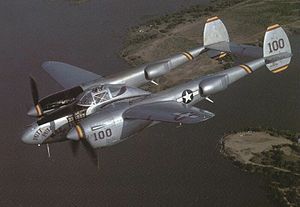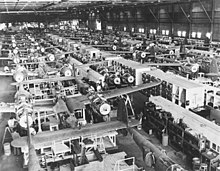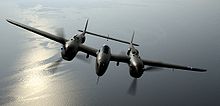Lockheed P-38
| Lockheed P-38 Lightning | |
|---|---|
 Lockheed P-38J "Lightning" |
|
| Type: | |
| Design country: | |
| Manufacturer: | |
| First flight: |
January 27, 1939 |
| Commissioning: |
1941 |
| Production time: |
1941 to 1945 |
| Number of pieces: |
10,037 |
The Lockheed P-38 Lightning (reconnaissance variants were designated as Lockheed F-4 or F-5 ) was a Lockheed Corporation fighter aircraft from World War II . The unconventional design with double tail girder was one of the USAAF's standard fighters in the Pacific War .
development
Designed as an interceptor , it fulfilled the function of a long-range escort and fighter-bomber . In February 1937, Lockheed, as well as Boeing , Consolidated , Curtiss , Douglas and Vultee, were asked to participate in a tender of the United States Army Air Corps (USAAC), which required the design of a twin-engine interceptor. The minimum requirements were:
- 580 km / h at 6,000 m altitude (360 mph at 20,000 ft )
- 466 km / h at sea level (290 mph)
- withstand full throttle at an altitude of 6,000 m for at least one hour
- Can overcome a 15 m high obstacle 670 m after take-off (50 ft after 2,200 ft)
Hall Hibbard and Clarence “Kelly” Johnson , after analyzing various designs, presented the USAAC commission with the model “22-64-01”, which had a design with double tail booms and a central fuselage nacelle. Despite the construction, which the jury classified as critical - because it was completely new - they decided on the model designed by Lockheed on June 23, 1937.
- For driving two ensured the left and right of the cockpit installed liquid-cooled , with turbochargers provided twelve-cylinder - V engines of type Allison V-1710 , each with 1,150 hp (858 kW) starting power. In order to balance the gyroscopic forces of the two propellers , they turned in opposite directions.
- The central fuselage nacelle with the cockpit was equipped with a Hispano Suiza M2 machine cannon of caliber 0.79 in (20 mm) and four Browning M2 machine guns of caliber .50 BMG (12.7 mm).
Versions
- XP-38
- Prototype with inward rotating, 858 kW Allison V-1710C engines, a machine was built.
- Two Allison V-1710-11 and -15 liquid-cooled V12 engines, rotating inward, developing around 858 kW (1,150 hp) with General Electric B1 turbochargers . The Allison engines had not yet been tested much in 1938 (approx. 150 hours for the 745 kW version).
- The top speed was 664 km / h (413 mph in 20,000 ft).
- Ascent time to 6,000 meters: 6.5 minutes.
- The maximum flight altitude was 11,582 meters (38,000 ft).
- The curb weight was 5,225 kg (11,507 lbs).
- Maximum take-off mass: 6,992 kg (15,416 lbs).
- Maximum landing mass: 6,341 kg (13,964 lbs).
- The fuselage nacelle carried the pilot's cockpit; the machine was unarmed.
- YP-38
- Pre-production aircraft with outward turning V-1710-27 / 29 with B-2 turbochargers, each 858 kW (1,150 hp). Armed with two 7.62 mm and 12.7 mm machine guns and one 37 mm cannon, 13 were built. The YP-38 was actually the production version of the prototype XP-38. It was a bit lighter than the XP because its structure had been redesigned. The YP was still a bit slower than the XP because it had wider cooling flaps. A problem arose when diving because the tail tended to flutter strongly .
- Two 858 kW (1,150 hp) Allison V-1710-27 and -29, with General Electric B2 turbochargers and liquid cooling, rotating outwards.
- Larger coolers than on the XP-38 were used.
- The top speed was 651 km / h at 3,000 meters (405 mph at 10,000 ft).
- 6,000 m could be reached in just 6 minutes, another 30 seconds faster than the XP-38.
- The range was 650 km.
- The curb weight was 5,067 kg (11,171 lbs).
- The maximum takeoff mass was 6,508 kg (14,348 lbs).
- The maximum landing mass was 6,123 kg (13,500 lbs).
- The armament consisted of two 7.62-mm (0.30-in) and two 12.7-mm (0.50-in) machine guns, a 20-mm cannon and a 37-mm Browning M9 cannon .
- P-38
- Production version with four 12.7 mm machine guns and one 37 mm cannon, 30 were built. The P-38 had the same engines as the YP-38. The armament was changed, however, it consisted of a 37-mm cannon and four 12.7-mm machine guns. An additional armor plate and bulletproof glass were added to improve the safety of the pilot.
For night flights, phosphorescent instrument labels were attached.
- XP-38A
- Conversion of a P-38 and equipment with a pressurized cabin and a 20 mm cannon (but was not installed).
- P-38B / C
- not forgiven. Based on the experience of the air war in Europe, USAAC decided that all aircraft should be armored and equipped with self-sealing fuel tanks. Aircraft equipped in this way should always be identified as version “D”.
- P-38D
- P-38 with self-sealing tanks , 36 were built.
- P-322 (Lightning I)
- the British Royal Air Force ordered 143 P-38Ds, but the USA were only prepared to deliver these with V-1710-C15 without a turbocharger. The RAF then rejected the machines. 143 were built, 3 went to the RAF, 140 were used by the USAAF as "P-322" training aircraft.
- P-38E
- first large-scale version with a 20 mm cannon, 210 were built.
- P-38F
- 1325 hp V-1710-49 / 53, equipped with additional tanks under the wings, 527 were built.
- P-38G
- 1325 hp V-1710-51 / 55, compared to the P-38F the weight was reduced, later P-38G could be equipped with bombs and missiles at lower wing stations. 1,082 were built.
- P-38H
- 1425 hp V-1710-98 / 91, 601 were built.
- P-38J
- Intercooler relocated to the oil cooler below the engine, additional fuel tank in the wing, dive brake , 2,970 were built.
- P-38K
- aerodynamically improved P-38J with greatly improved flight performance. Since the ongoing series production would have been interrupted for a few months due to the necessary conversion of the production facilities, series production was refrained from.
- P-38L
- 1425 hp V-1710-111 / 113, 3,923 were built, of which 3,810 at Lockheed (P-38L-LO) and 113 at Vultee (P-38L-VO). Some P-38L were modified with a bomb sighting device in a glazed nose and space for a bombardier as a pilot aircraft.
- P-38M
- Conversion of 75 P-38L as a night fighter, equipment with a second cockpit and APS-6 radar in a container under the aircraft nose.
spotter

- F-4
- Reconnaissance version of the P-38E, 99 were built.
- F-4A
- Reconnaissance version of the P-38F, 20 pieces built.
- F-5A
- Reconnaissance version of the P-38G, 181 were built.
- F-5B
- Reconnaissance version of the P-38J, 200 were built.
- F-5C
- Reconnaissance version, 123 (128) converted from P-38J
- XF-5D
- a converted F-5A ( Bobbie I ), camera operator face down in a glazed bow
- F-5E
- Reconnaissance version, 205 converted from P-38J, another 508 converted from P-38L-1
- F-5F / G
- Reconnaissance version, conversion from P-38L-5, F-5G had different camera equipment than F-5F
commitment
In Europe, the P-38 was initially used as an escort fighter for the American bomber units, as the other types of fighter used, such as the P-40 Warhawk and the P-47 Thunderbolt, initially did not have the necessary effective range for missions as far as Germany. In this role, however, the type - similar to the German Messerschmitt Bf 110 before it - was not particularly successful. Almost all units of the 8th Air Force , which recorded 451 P-38 total casualties, were converted from the P-38 to the P-51 Mustang from December 1943 .
In North Africa , the Lightning was first used in large numbers in November 1942 by the 12th Air Force . It was particularly successful as a fighter-bomber against ground targets or as an interceptor against German and Italian transport aircraft. Although it proved to be cumbersome in aerial combat with fighter planes of the Axis Powers, from 1943 onwards it played an important role as an escort fighter for the US bomber units. The aviators of the German Air Force soon gave the aircraft the nicknames "Doppelschwanz", "Gabelschwanz" or "Gabelschwanzteufel" because of its peculiar exterior and enormous firepower. 23 German Luftwaffe pilots shot down P-38s five or more. Some of these P-38s could be captured or made airworthy again and were used by the 2nd Squadron of the Test Association Commander in Chief of the Air Force . The P-38 units suffered great losses in Europe on June 10, 1944 in an attack supporting the bombing of the Ploieşti oil fields . The 82nd Fighter Group (82nd FG) was supposed to carry out fall attacks, while the 1st FG acted as hunting protection. The 94 deployed P-38s came across a Romanian airfield and were intercepted by a large number of IAR-80s . With five Romanian casualties almost all machines of the 71st Fighter Squadron, a squadron of the 1st FG, were lost.
The numbers produced were not very high, but since the P-38 was mainly used in the Pacific due to the rejection of the type by the 8th Air Force , this type destroyed more Japanese aircraft than any other fighter in the USAAF. In the Pacific War, the P-38 played a role mainly because its two engines were seen as safety for flight over the open sea. The most successful American fighter pilots of all time (Richard I. Bong with 40 kills and Thomas B. McGuire with 38 kills; both received the Congressional Medal of Honor) achieved their successes on this pattern. The 475th Fighter Group alone, to which McGuire also belonged, shot down over 551 Japanese aircraft during the entire war with the loss of only 56 of its own aircraft. One of the Lightning's most famous missions during the war was Operation Vengeance on April 18, 1943, in which the chief commander of the Japanese fleet, Admiral Yamamoto , was killed in his transport plane.
The Lightning was also used as a photo reconnaissance aircraft. The most famous pilot of the Lockheed F-5B was the writer Antoine de Saint-Exupéry , who was shot down south of Marseille on July 31, 1944 .
production
| Manufacturer | version | 1939 | 1940 | 1941 | 1942 | 1943 | 1944 | 1945 | TOTAL |
|---|---|---|---|---|---|---|---|---|---|
| Lockheed, Burbank | XP-38 | 1 | 1 | ||||||
| YP-38 | 1 | 12 | 13 | ||||||
| P-38 | 30th | 30th | |||||||
| P-38D | 36 | 36 | |||||||
| P-38E | 127 | 83 | 210 | ||||||
| Lightning Mk. 1 | 3 | 3 | |||||||
| P-322 | 140 | 140 | |||||||
| P-38F | 527 | 527 | |||||||
| P-38G | 512 | 570 | 1,082 | ||||||
| P-38H | 601 | 601 | |||||||
| P-38J | 1,041 | 1.929 | 2,970 | ||||||
| P-38K | 1 | 1 | |||||||
| P-38L | 2,257 | 1,553 | 3.810 | ||||||
| Consolidated, Nashville | P-38L | 113 | 113 | ||||||
| Lockheed, Burbank | F-4 | 2 | 97 | 99 | |||||
| F-4A | 20th | 20th | |||||||
| F-5A | 97 | 84 | 181 | ||||||
| F-5B | 200 | 200 | |||||||
| XP-49 | 1 | 1 | |||||||
| XP-58 | 1 | 1 | |||||||
| TOTAL | 1 | 1 | 207 | 1,480 | 2,497 | 4.187 | 1,666 | 10,039 | |
Technical specifications
The machine was designed aerodynamically clean and had good maneuverability for its size. In each engine nacelle, the turbocharger with the exhaust system was located on the upper side of the wing behind the engine ; underneath was the landing gear well and behind it the radiator . Because of the long intake and exhaust paths, the engine noises were strongly muffled so that the machines were relatively quiet.
As night fighters , the last P-38 M were fitted with an attached radome for the radar antenna and were given an additional radar observer, which was located in the cockpit behind the pilot on a slightly raised seat. The design was the model for the Northrop P-61 , which was developed as a special night fighter aircraft.
| Parameter | Data |
|---|---|
| crew | 1 |
| length | 11.53 m |
| span | 15.85 m |
| height | 3.00 m |
| Wing area | 30.42 m² |
| Empty mass | 5,805 kg |
| Max. Takeoff mass | 9,798 kg |
| drive | 2 × V-12 engines Allison V-1710 -111 with turbocharger and each 1600 hp (1193 kW) |
| Top speed | 666 km / h at an altitude of 7,620 m |
| Service ceiling | 13,410 m |
| Largest range | 4,184 km |
| Armament | 4 × 12.7 mm machine guns, 1 × 20 mm cannon, up to 1,820 kg bombs or 127 mm missiles |
Trivia
In July 1942, eight P-38s were to be transferred from the USA to England as part of Operation Bolero . Two lightnings had to turn back due to technical problems, after the refueling stop in Greenland the next stopover in Iceland was planned. On the way there, the navigators in the accompanying B-17s lost their bearings due to bad weather and problems with radio communications. After a long odyssey, the group, later named " Lost Squadron ", had to return to Greenland, but could not reach an airfield due to a lack of fuel. All six planes landed safely on the Greenland ice sheet, around 150 kilometers southwest of a city that is now called Tasiilaq . All crew members were uninjured and were rescued by the US Navy after a few days. In 1992 one of the P-38s was recovered. She was christened “Glacier Girl”, is now flying again and can be seen at air shows, especially in the USA. The remaining five lightnings were about 100 meters below the surface in 2006.
Another P-38 was spotted on a beach in Wales on July 31, 2007. The Wales Lightning, built in 1941, came to the British coast in 1942 and flew combat missions along the Dutch-Belgian border. Second Lt. Robert F. "Fred" Elliott, 24, of Rich Square, NC, was on a training mission on September 27, 1942 when a fuel problem forced him to make an emergency landing. Apart from the missing wing tip and missing armament, the machine is in good condition.
A Lightning that has been completely restored or partially rebuilt by Ezell Aviation in Breckenridge / Texas has been on view at the Flying Bulls in Hangar-7 at Salzburg Airport since March 2009 . This machine is airworthy and is flown at air shows.
See also
literature
- Olaf Groehler , Karl Hafenrichter: History of the aerial warfare 1910 to 1980. Military publishing house of the German Democratic Republic, Berlin 1981, ISBN 3-327-00218-5 .
- Friedrich König: The History of the Air Force. Pabel, Rastatt 1980 ( DNB 851004520 ).
Web links
Individual evidence
- ↑ Tom Philo: 8th Air Force Combat Losses in World War II ETO Against the AXIS Powers. In: www.taphilo.com. Retrieved March 4, 2020 .
- ↑ P-38 Lightning Killers. In: www.luftwaffe.cz. Retrieved March 4, 2020 .
- ↑ David Donald: Lockheed P-38 Lightning - Warplane Classic. In: International Air Power Review Vol. 14, 2004, p. 138 f.
- ↑ 475th Fighter Group Historical Foundation - Unit History. 475th.org, accessed March 4, 2020 .
- ↑ Statistical Digest of the USAF 1946. pp. 100 ff .; www.uswarplanes.net










